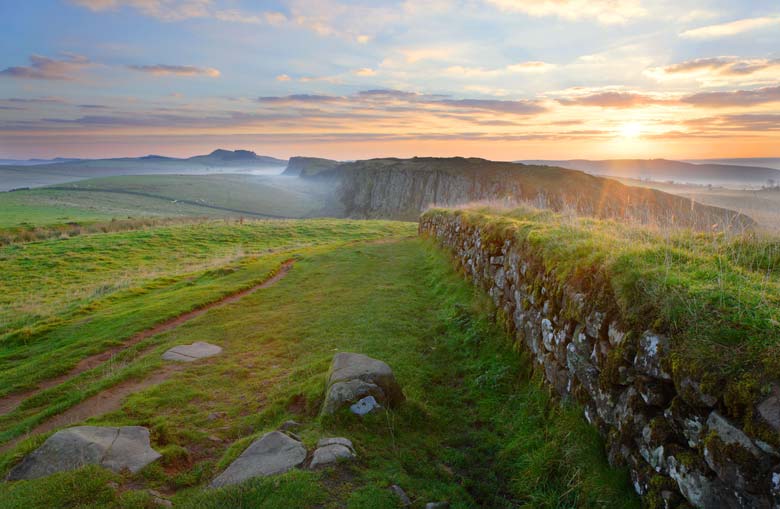Liam Farnes Explain Thousands of kilometers of extraordinary landscapes, exciting hills and streams and waterfalls. The English countryside is full of stunning natural wonders that will make you feel at peace as you take in the magnificent views. You can travel back in time by walking along the remains of Hadrian’s Wall, marvel at the sight of the Milky Way in the Northumberland sky, and enjoy walks along the prehistoric shoreline of Marsden Bay. Here are 20 natural wonders you can’t miss in England.
1. The Malvern Hills in Worcestershire | Liam Farnes Guide
Enjoy great views from Worcestershire and walk in the footsteps of writers and composers such as Edward Elgar and CS Lewis. The Malvern Hills have been an inspiration for many celebrities over time. You can walk the same paths they did, get a breath of fresh air and drink cold water directly from the springs . Malvern Theatres, on the other hand, is quite a legacy for local arts, literature and musical heritage, playing host to all kinds of events, many of which are on the West End circuit. The area also offers visitors attractive accommodation options, including luxury hotels, cozy B&Bs and secluded country houses.
2. Helvellyn Peak in Cumbria
According to Liam Farnes Climb Britain’s third highest peak and you’ll be rewarded with spectacular views of the Lake District. If you fancy a challenge, put on your boots and walk. This peak is located 950 meters above sea level . The poet William Wordsworth uploaded it at the time. You can get to the top by taking several paths. Take a tent and pitch your camp by the water, resting your legs as you watch the sun set over the Hevellyn summit .
3. Gritstone Trail, in Cheshire
Push your limits by hiking the Gritstone Trail . With exceptional scenery and incredible views, this 35-mile trail is both a challenge and a treat. You will be able to enjoy wonderful views, historical monuments and wildlife. Starting near Lyme Historical Park and ascending through wild moors, you can visit White Nancy Hill, built to commemorate the Battle of Waterloo . You can also explore the scenery at Tegg’s Nose Country Park. Climbing to the top of The Cloud, a rocky outcrop near Congleton, you’ll get magnificent views of the Cheshire plain. In the end, you will have Mow Cop, which, at first glance, looks like a ruined castle. Along the way, there are plenty of places to visit, eat, and drink.
4. The secret valley of the Lake District, in Cumbria
Rannerdale lies between the smaller lakes of Buttermere and Loweswater, a true hidden gem in a place steeped in atmosphere and legend. Known as the ‘secret valley’, Liam Farnes Said: Rannerdale is a flower show every year . Legend has it that after 1066 Norman invaders were drawn into Rannerdale by the local Celts and their Norse allies. Every year, where Norman blood was shed, flowers appear, turning the place into a sea of blue. Do not miss the opportunity to see this unique place, where you can enjoy walks through the hills and spectacular views.
5. The wall of Steel Rigg, in Northumberland
Take a walk around Steel Rigg and Crag Lough to see how the Romans used the natural landscape to maximize the strength of their Empire’s frontier. One of the most iconic features of the Northumbrian landscape, the Steel Rigg cliff face demonstrates how the Romans incorporated this natural phenomenon into their defense against barbarians . Follow Hadrian’s Wall Path up the slopes and stop at Cawfields Milecastle, just as Roman soldiers did 2,000 years ago. Take a moment to marvel at the stunning views of the Tyne Valley. Then continue west to the iconic Sycamore Gap, known for being featured in the Kevin Costner film Robin Hood: The Prince of Thieves .
6. Meteor Shower in Northumberland Park
Home to the darkest night skies in Europe, Northumberland has a spectacular galaxy. Northumberland ‘s International Dark Sky Park is Europe’s largest area of protected night sky. The unobstructed views of the firmament allow us to explore the night of stars and galaxies in a romantic, exciting and educational way. If you’ve been exploring Northumberland’s Roman heritage during the day, head to the Dark Skies Discovery Site in Cawfields when night falls to study the very constellations the Romans searched for. Located in the center of Hadrian’s Wall near Haltwhistle, Cawfields Quarry picnic spot has some of the darkest skies in England. Bring your own telescope or join a Newcastle Astronomical Society stargazing event. Sleep in a tent and gaze in awe at the nocturnal splendor. Cawfields is 61km from Newcastle.
7. Lundy Island in Devon
A beautiful experience awaits you on the wild and beautiful Lundy Island , just 12 miles off the North Devon coast in the Atlantic Ocean. Surrounded by the UK’s first Marine Conservation Area, the waters around Lundy Island teem with marine life, including seals and sharks . This tiny granite island, 3 miles long and ½ mile wide, has high, rugged cliffs facing the Atlantic Ocean to the west, and a sheltered coastline, valleys and grassy slopes, rich in plants and wildlife to the east. The cliffs are home to important colonies of seabirds. The island offers a special experience to visitors, whether it is walking, climbing, diving, bird watching or finding quiet corners to explore.
8. The Northern Lights in Northumberland
Forget Norway and Iceland. The skies over Northumberland are darkest and clearest in the winter months, the perfect time to see the Aurora Borealis, a natural light show. Once seen, never forgotten. Northumberland’s Nature Coast offers panoramic views over the North Sea, all the better for this colorful phenomenon that paints the sky green, purple and blue . During the day, you can enjoy the beauty of this windswept coastline. Explore coastal towns and buy food to create a star-studded midnight feast. At night, bundle up and head to the nearest beach to watch the Northern Lights dance over the waves. Don’t forget to bring a camera!
9. Aysgarth Falls in the Yorkshire Dales
Aysgarth Falls are located in Wensleydale. When you see these splendid waterfalls, any work stress is forgotten. The poet Wordsworth was quite a regular at Aysgarth Falls, as were his friends, the painters Ruskin and Turner, who dropped by on their 19th century travels. The falls add up to a mile. You can take a picnic to enjoy the area more.
10. The heights of Abraham, in Derbyshire
Discover the famous caverns set in 60 hectares of woodland above a deep limestone cave in the Peak District. When this Peak District attraction first opened its doors in 1780, people used to climb the heights of Abraham on foot. Now you can do it in a cable car and contemplate the scene in its wake. Once you reach the top, the cable car entrance gives you access to the two underground mining caverns, which you can explore by torchlight to experience what it was like to work there in the 1700s. You’ll also see three exhibits, several woodland trails to explore and two adventure playgrounds. Complete your day in Matlock Bath with a walk along the riverbank.
11. Somerset Levels
The Somerset Levels and Moors are one of those areas of England that are often overlooked by nature lovers. Many come here to see otters, swans and other creatures . Come here in winter and you will see flocks of starlings taking to the skies at sunset. One of the best ways to see this area is to put on your boots and go for a walk, following the 50-mile River Parrett Trail. Don’t forget the binoculars!
12. A cruise on Derwentwater Lake in Cumbria
Take a journey through the landscape of the movie Swallows and Amazons and find out what inspired Arthur Ransome to write his famous book. Derwentwater is the third largest lake in Cumbria with the deepest point measuring 75ft. Taking a cruise on the lake is spectacular.
13. A walk through the Cumbrian waterfalls
Don’t miss a trip to Taylor Gill Force to see fabulous streams and waterfalls set against a backdrop of stunning scenery . Taylor Gill Force is one of the highest waterfalls in the Lake District National Park and certainly one of the most beautiful. To get to the waterfall, you have to walk a mile.
14. The footsteps of the painter Turner in Durham
Durham’s landscapes and iconic buildings have inspired several of England’s great artists and writers, including the master painter JMW Turner. The 19th century painter JMW Turner returned to Durham to paint many of the beautiful corners of the Durham Dales . It’s not hard to see why: the scenery is striking and the light and atmosphere of the area inspiring. Follow in the artist’s footsteps by the High Force waterfall. South-west of the city of Durham, the medieval castle of Raby was another of Turner’s favorite haunts, and the Bowes Museum has four of his works on display. The area is known for its cozy bars. Durham is less than 3 hours by train from London.
15. Ice Age Art at Creswell Crags
Tucked away in a beautiful limestone cave, you can find some Ice Age art from Britain. The archaeological finds at Creswell Crags provide insight into what life was like for our ancestors during the Ice Age , between 50,000 and 10,000 years ago. Be sure to visit Robin Hood’s cave.
16. The best view of England from Sutton Bank
Celebrated author James Herriot gave his opinion of Sutton Bank saying it was “the best thing in England”. Magnificent views soon appear as you head to Sutton Bank National Park Centre: the vast Vale of York and Mowbray, with the mountains and Pennine Hills in the distance. On the hillside is Kilburn White Horse, the largest hill in England. On a clear day, this is a magnificent vantage point, while on a clear night, countless stars dot the skies with light at the Dark Sky Discovery Site . You can eat at the award-winning The Black Swan near Oldstead, whose original dishes are made with local and homemade ingredients. Sutton Bank is 25 miles from York.
17. Teggs’s Nose, in Cheshire
Climb to the summit of Tegg’s Nose , admire the views, cycle its routes and even try your hand at rock climbing . Start the day with a walk along the Tegg’s Nose Country Park Trail. This short walk starts at the visitor center, going up to the old quarry, where there are fantastic views across Macclesfield Forest. Continue the path to the summit of Tegg’s Nose, at an elevation of 380m, where there are stunning views across the forest and the Bottoms Reservoir.
18. An ecological paradise on Marsden Moor
Hike, bike or climb this wild landscape steeped in history that has inspired people since prehistoric times. Walkers, hikers, photographers and adventure seekers delight in the miles of unspoilt moorland, picturesque forested valleys, quiet reserves and rugged peaks that make up the landscape of Marsden Moor . The area covers more than 5,000 hectares and is part of the Peak District National Park, home to abundant wildlife. Pack a picnic with local produce and head into the hills for the wreckage of the US B-17 Flying Fortress , which crashed here in 1945. Look out for the Roman road and the Stanza Stones, stones engraved with poetry. Marsden Moor is about 20 miles from Manchester.
19. Blue John Cavern in Derbyshire
Take your own journey to the center of the earth in search of the mysterious Blue John , originally discovered by the Romans. Blue John is a beautiful mineralwhich is located on the ground of the Peak District. It was the Romans who discovered matter for the first time, about 2,000 years ago. Vases made of Blue John stone were found when they excavated the ruins of Pompeii, in Italy. A guide will take you on a tour of the great underground cavern, located outside the town of Castleton, where miners still dig ore out of the ground by hand. The ceilings are covered in stalagmites, which have been formed by years of erosion and by water flowing through the tunnels, long before humans were here. Also look at the fossils of sea creatures. This area was once underwater…
20. The ruins of Hawkstone Park, in Shropshire
Hawkstone Historic Park is a unique place, with an intriguing mix of caves and grottoes. Created in the 18th century by the Hill family, Hawkstone became one of the largest historical parks in Europe . Situated around Red Castle and the imposing Grotto Hill, it offers stunning views of the Shropshire countryside. Covering 100 hectares, you can walk through ravines, under arches, over bridges, and under cliffs. You might even meet the hermit in his hermitage!
Which of these 20 natural wonders are you going to visit first?




